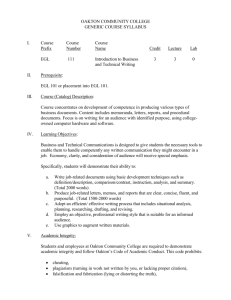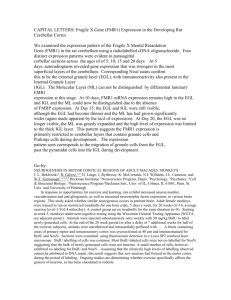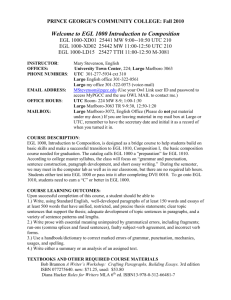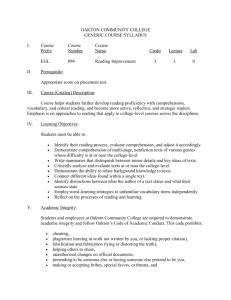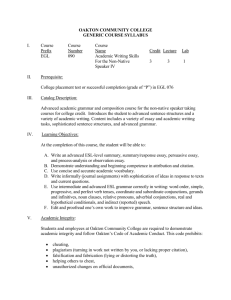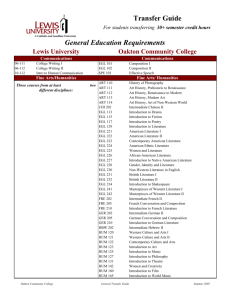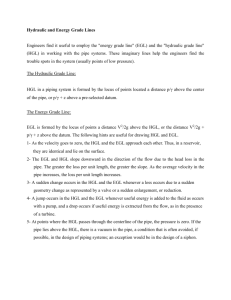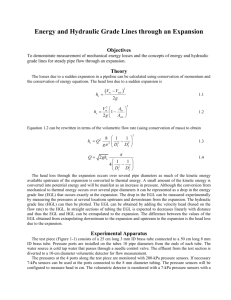FOR Statement
advertisement
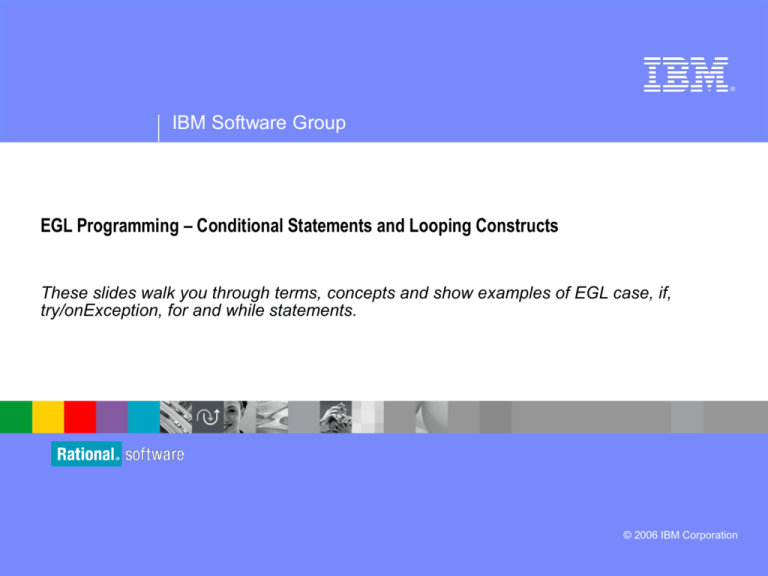
®
IBM Software Group
EGL Programming – Conditional Statements and Looping Constructs
These slides walk you through terms, concepts and show examples of EGL case, if,
try/onException, for and while statements.
© 2006 IBM Corporation
UNIT
Programming in EGL
Topics:
The EGL Programming Model – Terms/Concepts
EGL Data Parts and Assignment Statements
EGL Conditional Logic and Looping Statements
The EGL Built-in Functions and Date Math
2
More Logic! EGL Conditional and Looping Statements
Conditional statements transfer control within a statement-block based on a logic
decision. EGL offers the following conditional statements:
case
if, else
try/onException
Loop statements test a condition to determine how many times to repeat a set of
statements. Some part of the loop must change the initial condition tested. EGL
offers the following loop statements:
for
Loops through a statement block n times – automatically incrementing a counter
forEach
Loops through a relational cursor fetch – or a file read operation until end-of-file is reached
while
Loops until a condition is met. Note: For while, you must explicitly ensure the condition happens
In addition, there are three EGL statements that are used for navigation within
conditional and loop statements:
continue
exit
return
3
EGL Conditional Logic Statements
Conditional logic plays a large role in any production business application, and EGL
provides all of the standard keywords you’d expect from a mature 4GL:
if
if-else
compound if - two or more if conditions logically connected with and/or operators
case statement
try/onException - allows your application to recover from certain types of run-time
failure conditions
In addition, EGL provides many productivity-enhancing extended conditional
expressions:
in - allows you to search an array or EGL DataTable for a value (DataTables are
covered later in this course)
like – allows you to use SQL wildcard search characters to test for specific values or
patterns in strings
matches – allows you to use a set of reserved wildcard characters to do more
extensive text search than like
is/not – allows you to test for specific categories of conditions in string and char
variables
is/Not Numeric – tests for legitimate (or not) numeric data in a char field
is/Not Blanks – tests for spaces in data
4
Simple if/else Conditional Statement
From the example shown, note the following:
The reserved word if precedes the condition
The condition is enclosed inside parenthesis (…condition…)
The condition can include the logical operators covered in the previous topic
The condition comparison must resolve to a boolean true/false –If the condition
is true any/all statements following the condition are executed – within the if/end
scope terminator
The if/equals comparison specifies two (double) == signs as the condition
If the condition is false, any/all statements following the else path are executed
The final else does not participate in an if (thus if both if statements test false,
this else is executed)
Each if statement block is closed by an end (scope terminator)
The else statement block is considered part of the if statement it is associated
with – thus, end follows the else portion
EGL Conditional
Operators
Use Content Assist
5
Compound if/else Conditional Statements
In the example above, each if statement has two conditions, connected by &&
Each single condition is enclosed in parenthesis - and the entire compound if
statement is enclosed in parenthesis in a second set of parenthesis
The same rules about end and else apply to compound if
Each if statement must be terminated by an end statement in a matching pair. In
this example there are three if statements and three end statements (the fourth and
final end statement terminates the entire function).
Compound if statements are written with and (&& - or the word AND) and/or
(|| - or the word OR) operators separating each condition
&& (AND) – designate a logical AND connection between two conditions
Unless all conditions connected by && test true, the else path is taken
|| (OR) – designate a logical OR connection between two conditions
If any single condition connected by || tests true, the true path is taken
6
case Statement
Example, inspect the value returned from an EGL DateTimeLib function
(monthOf) on the empRecin.reportTimeStamp value.
If the value is 1 – 3, do 1st quarter processing.
If the value is 4 – 6, do 2nd quarter processing.
If 7 – 9 do 3rd quarter processing.
If > 9 its end of year processing (note – this logic assumes values 1 – 12)
The EGL case statement marks the start of multiple sets of statements, where at
most only one of those sets is run.
CASE is equivalent to an RPG SELECT, COBOL EVALUATE, C or Java switch
statement that has a break at the end of each case clause.
Note that the above statement could have been coded with if/else statements.
However, case may be easier to code, test and maintain (for logic such as this), and
in some languages (like Java) case can outperform if/else at run-time.
You may also code conditions inside each of the when(…) statements
As with most EGL statements, use Content Assist to create.
7
*** See Notes: - For
additional examples!
IN Conditional Operator – Searching Through Arrays in a Single Statement
The EGL in keyword allows you to test for the presence of a value in an array or EGL
DataTable. Typically you would have to write a for loop to test for this condition. Instead you
can code (and maintain) far fewer statements using in .
Example: Assume an array of customers, loaded from the database, and a string variable
named: srchString – return a message to a control on a .JSP page
if (srchString in customers.Last_Name || srchString in customers.First_Name)
sysLib.setError("Search String in Array");
else
sysLib.setError("Search String NOT in Array");
end
Note that in returns an EGL reserved system index value sysVar.arrayIndex. This index
value designates either: 0 for not found … > 0 for the array occurrence in which the IN match
occurred
You can use the sysVar.arrayIndex value to further process the array information.
if (srchString in customers.Last_Name ||srchString in customers.First_Name)
move customers[sysVar.arrayIndex].Last_Name to temp_name;
else
sysLib.setError("Search String NOT in Array");
End
Finally - note that you can extend in – with “from <start>” – where start <start> is an
integer value within the range of the Array.
See Notes – on negating an IN condition
8
Like and Matches Conditional Operators – Complex Text Search
LIKE Keyword
Like allows you to use SQL LIKE wildcards to search for text patterns in a string.
% = 0 – n wildcard characters allowed
_ (underscore) exactly one wildcard character allowed at this position in the string
Matches Keyword
Matches are similar to Java “regular expressions” – and extend the capability of doing LIKE text
searches with terse patterns. They allow you to setup complex text-search-pattern-masks that
can be used to solve the kinds of sophisticated text-matching problems you may find in
production specifications. Please read the Product Help on Matches (search on: matches
operator)
Matches examples:
Find non-Alphabetic (upper and lower-case letters) in a string
if (strField matches "*[^A-Za-z]*") //tests-true
Find non-Numeric (values) in a string
if (strField matches "*[^0-9]*")
for any non-alphabet character
//tests-true for any non-numeric character
Test for a valid routing code in a string: ##-##-##
if (!(routing_code matches "[0-9][0-9][-][0-9][0-9][-][0-9][0-9]"))
9
IS and ISA Conditional Operators – Categories of Conditions
IS Keyword - IS allows you to test for categories of conditions with the following
keywords:
if (strField is/is not numeric) //tests for fields containing only numeric characters
if (strField is/is not blanks) //tests for fields containing only blanks (spaces)
if (EGLSQLRecord is noRecordFound) //tests results of last relational database I/O operation against the
SQLRecord. Returns true, SQLCode indicates no data returned
ISA Keyword
ISA allows you to test for data types at run-time
if (field isa ___ ) //tests-true for a valid data type
Note – isa primarily used to interface with Java class types
10
EGL Loops - FOR Statement
The EGL for statement governs a loop that runs until a counter reaches a
specified value.
You provide an initial value for the counter, a limit for the counter, and an
optional amount by which EGL automatically increases or reduces the value
of the counter after completing each loop.
The keyword end marks the close of the for statement – and the test is
done before the code within the statement block is executed.
Use Content Assist to create the for statement – and don’t forget to Tab
through each of the Content Assist-able options within the parens!
11
EGL Loops - WHILE Statement
The EGL keyword while marks the start of a loop that runs as long as a
specified logical expression resolves to true.
The keyword end marks the close of the while statement .
Unlike the FOR statement – which automatically increments the loopcounter, you are responsible for ensuring that a WHILE loop ends.
You would typically use WHILE to run until a condition was met – and use
FOR to loop through code “n” times.
Use Content Assist to create the WHILE statement.
12
“Take it from the top” – continue Statement
The EGL continue statement returns control to the start of a statement block
controlled by a for, forEach or while statement.
EGL evaluates the conditions for continuing the loop at that point, and either
continues executing the loop or exits to the next statement.
Examples:
Add the value in sum to an inputArray[], but only for the 5th through 10th elements:
for (i from 1 to 10 by 1)
if (i < 5) continue;
//sum, only for inputArray[5->10]
end //end-if
sum = inputArray[i] + sum;
end //end-for
The following example prints the members of an array, inserting a blank line between each
group of ten. Note – continue returns control to the start of the for loop.
for (i from 1 to 100 by 1)
printReport(myArray[i]);
if ((i % 10) != 0) continue; // return to printReport(myArray[i]);
end //end-if
printReport(blankLine);
end //end-for
13
Breaking out of EGL Loops – EXIT Statements
The EGL exit statement provides an immediate exit from all or part of a function or of a block
of code controlled by a conditional or loop statement.
If you do not specify a modifier, exit transfers control out of the most recently entered block of
code governed by a case, for, forEach, if, openUI, or while statement. If the exit
statement is not inside a loop or condition, it transfers control out of the most recently entered
function.
If you specify one of the following modifiers, the exit statement passes control out of the most
recently entered loop of that type:
case
for
forEach
if
openUI
while
Example:
for (i from 1 to 10 by 1)
if (sum > 1000) exit for; //branches to: sumDisplay = sum;
end //end-if
sum = inputArray[i] + sum;
writeStdOut(sum as string); //Write if sum <= 1,000
end
sumDisplay = sum;
14
Ending an EGL Function – return Statement
The EGL return statement exits from an EGL function and optionally
returns a value to the invoking function.
function main()
//Do stuff
calculateResults();
writeStdOut(msg); //next statement after return
end
function calculateResults()
if (timeDays == 0)
msg = "Please enter the timeDays as a number of days. Thanks.";
return; //leave this EGL function – and return to writeStdOut(); in main()
end
if (principal == 0)
//additional code inside the function
end
end
15
Run-time Exception Handling – try/onException
EGL refers to program errors as
exceptions. An exception can occur when
an EGL-generated program does any of the
following:
Accesses a file, queue, or database
Calls another program
Invokes a function
Performs an assignment, comparison, or
calculation
try
Statement
Block
Program
Exception
You can choose to handle certain types of exceptions or for all exceptions. To handle an exception means that
you do not allow the current program to terminate –
resulting in a run-time error, but provide special
processing for the circumstances.
The mechanism that EGL uses to handle errors is the
try block
Any statement that throws an exception inside a try
statement block causes the program to look for a
matching onException statement block within that
same try statement block. If an onException
statement block exists that references the exception
thrown, control passes to the code within that block.
16
Matching
onException?
Run-time Error
Handle Exception
try/onException - Syntax
The basic format of try/onException is:
try
//some EGL functionality
onException (<exceptionRecordVar> <exceptionRecordType>)
//Do something to trap the error without abending
end
Notes:
If there is no run-time error, execution falls through to the statement after end
If an exception occurs that is not accounted for (handled with exceptionRecordType)
you will get a run-time error
You can put any statements you want in the try block and in the onException block
But typically, code in your onException block will transfer control to a page – or something that
ends the application gracefully
You can wrap your entire application’s logic in a try /onException block, which will
handle exceptions no matter how or (more to point) when they occur (in sub-routines, or
calls to library functions or services anywhere in the statement call-chain
The exceptionRecordType provides the following (in all cases):
– Error Code, Error Message
There is additional information for specific error conditions with different
exceptionRecordTypes
You can explicitly throw exceptions as well
17
try/onException – What are the Exception Types and Records
When an
error
occurs the
system
looks for
an
exception
category
first
A few Exception Categories
IndexOutOfBoundsException
J2EESessionRequestAccessException
JavaObjectException
Failing to find
a “category
exception”
coded, if the
error causes a
run-time
termination
Ex. Math
Overflow
Failing to find
a “category
exception”
coded, or
Runtime
Exception…
RuntimeException
AnyException
LobProcessingException
Program
Exception
ServiceBindingException
ServiceInvocationException
SQLException
TypeCastException
FileIOException
18
*** See Notes: - For additional
info on exception handling!
OPTIONAL TOPIC – Throwing Your Own (custom) Exception
Using an EGL throw statement, you can throw any of the predefined system
exceptions. As in exception handling, you must declare a variable based on the record:
nullEx NullValueException{};
…
throw nullEx;
In addition to the exceptions that the system defines, you can create your own exception
records. As with other records, you must define a Record part first, and then declare a
variable based on it.
Record CustomerException type Exception
customerNumber INT;
end
throw new customerException {
customerNumber = custNum,
message = "Illegal customer number" };
Custom exceptions records like this one automatically include the messageID and
message fields, just like the system exception records.
19
Workshop – Conditional Testing and Looping
Continue working with payrollprogram.
Create a series of EGL functions that
exercise the language concepts
discussed in this topic.
Steps:
1. Create the following set of function calls
in the main() function of the program
2. After you’ve coded them
• Select all of the function calls you just
coded and comment them out
Right-click and select Comment
You will now add the
individual functions and
then un-comment
calls to them from the
main() function, and
Debug the statements
(next slides )
20
Workshop – Code the if test Functions
Anywhere in the functions section of the source code, add the following two functions (see screen
capture below)
The simpleIfElse() function tests the 1st array element’s grossPay value against the 2nd
array element’s.
The compoundIfElse() function calculates ytdGrossPay for the 1st array element, based
on a compound AND/OR
Steps:
1.
2.
3.
Copy the function names down from the main()
Use Content Assist EVERYWHERE – to reference the empRecArray records and fields, and for writeStdOut
When your syntax checks clean (Ctrl/S)
1. Add breakpoints
2. Debug payrollProgram - step through the code, watch the variables change in the functions
21
Workshop – Code the InTest and whileLoopMatches Functions
In the functions section of the source code, add the following functions (shown below):
The inTest() function tests to find “Smith” in the lastName field in the array – in
one statement
The whileLoopMataches() function sees if any employees have a single uppercase letter in position 2 of empId
Steps:
1. Copy the function names down from the main()
2. Use Content Assist EVERYWHERE – to reference the empRecArray records and fields, and for
writeStdOut
3. When your syntax checks clean (Ctrl/S)
1. Add breakpoints
2. Debug payrollProgram - step through the code, watch the variables change in the functions
22
Workshop – Code the forLoop Function
In the functions section source code, add the following function (shown below):
The forLoop() function derives a sum, min, max and average from the grossPay
values in the empRecArray.
Steps:
1. Same as before – especially – use Content Assist everywhere
2. When your syntax checks clean (Ctrl/S)
1. Add breakpoints and debug your logic - step through the code, watch the variables change in the
functions
23
Workshop – Code the exceptionRef and continueExitReturn Functions
In the functions section of the source code, add the following functions (shown below).
The exceptionRef() function causes a run-time error – which trap with an
onException routine
Be sure to view the exception record values after execution
The continueExitReturn() function allows you to see the run-time behavior of
continue, exit and return – as they occur while looping and within conditional tests.
Follow the Debugging line-by-line instructions carefully here – to see your logic in slowmotion!
24
(OPTIONAL) Using try/onException Creatively – Date Validation
You can use try/onException to do things in V7 not possible in V6 – for example testing
string fields for valid dates
Steps
Add the validDation() function (in the Notes section) below to payrollProgram.egl – as a new
function, and add a statement to invoke the function. Then debug it. Note the exception record
information. Also note how useful this could be to your applications!
25
(OPTIONAL Topic) EGL and ASCII File Escape Sequences
These characters originated in the C language when writing to a console device and/or a
printer direct from the language to format text. Below is a list of supported codes embedded in
a sample program, and the output produced by running the program.
PROGRAM:
// escapeseq.egl demonstrates escape sequence codes when using writeStdOut()
/*
This program demonstrates the use of escape sequence codes when using the
writeStdOut() EGL function or writing to an error log file. Note: this
list originated in the C programming language. The following are supported
and demonstrated below:
\n
Newline
- inserts a CRLF (carriage return line feed)
\t
Horizontal Tab
- useful for formatting tabular output
\b
Backspace
- supported but not very useful in EGL
\\
Backslash
- lets you use a "\" in your text
\"
Double quote
- lets you embed double quotes in your text
*/
program escapeseq type BasicProgram
function main()
// use of \t for tabs
writeStdOut("Field1\tField2\tField3");
writeStdOut("AAA\tBBB\tCCC");
// use of \n for "newline"
writeStdOut("This is on the first line\nAnd this on the next line");
// use of \\ to allow use of the backslash "\" in your text
writeStdOut("This allows you to use a backslash \\ in your text");
// use of double quotes in your text \"
writeStdOut("Double \"quoted\" words");
end
end
26
Topic Summary
Now that you have completed this topic, you should be able to:
List the different types of EGL conditional statements
Describe at least 10 of the EGL conditional operators
Define the three EGL looping constructs
Define the use and behavior of:
Exit
Continue
Return
Describe the use of onException coding and handling of run-time errors
Code statements in programs that use EGL conditional and looping
expressions
27

